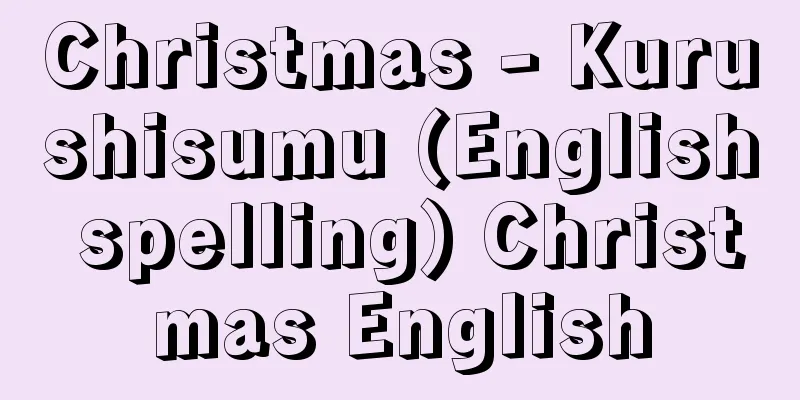Christmas - Kurushisumu (English spelling) Christmas English

|
A holiday commemorating the birth of Jesus Christ. It is also called the Nativity. The word means "worship of Christ." The interest of early believers was focused on preaching the events of Christ's death and resurrection, so the question of the date of his incarnation (birth) was imaginary, and the four gospels do not mention the date of his birth. Emperor Constantine, for political reasons, combined the Christian worship day "Lord's Day" with the Mithraic sun worship day, officially deciding on a weekly holiday in 321 and making it a holiday for officials. When the doctrines of Christology were organized at the Council of Nicaea (325) and the theological position of Christ's birth was established, December 25th, the Mithraic holiday Natalis Solis Invicti (birth day of the immortal sun), was interpreted and institutionalized as the birthday of Christ. Since the Savior was prophesied to be the "Sun of Righteousness" (Malachi 4:2), a convenient interpretation was established. Some of the forms of the Germanic winter solstice festival and the Roman festival of the agricultural god, in which bonfires were lit, candles were lit, and ritual games were held, were adopted by Christians, and candles, which are inconvenient even in modern times when electricity is used for lighting, are traditionally valued. This is useful for training people to emotionally understand the one and only life of Christ in the past, year by year, as light (the Son of God) shines in the darkness (the world), gives heat and light, and then disappears (sacrificial death). Since the 8th century, the period including the four Sundays before Christmas has been called "Advent" (the coming of the Lord). Although it is the beginning of the year in the church calendar, people avoid celebrations during this period in order to relive the birth of the Messiah and prepare themselves for the second coming of Christ. Christmas begins with Advent and continues until Epiphany (the day of the Epiphany) on January 6th, when all decorations are removed. The gift-giving and exchange of gifts dates back to the ancient Roman festival (December 17th) of Saturnalia (the god of agriculture). The attractions of this festival were extravagance, feasting, and the reversal of everyday roles and status. Since the tree is a custom north of the Alps and has magical origins, denominations with a lineage of Puritanism do not decorate it. The origin of Santa Claus is a strange combination of a terrifying kidnapper with a sack and a good old man, but the act of parents representing the goodwill and correct evaluation of a distant stranger is used in home education to convey God's providence. Christmas songs called "carols" developed from folk songs and express praise to God and joy and gratitude for the birth of Christ. Excellent carols are incorporated into hymns. One example is the song "Pure Night" composed by Gruber in the 19th century. [Shiro Kawamata] FolkloreChristmas has a wide variety of customs that have been passed down from pagan times. A boy bishop is a strange ritual that has existed since the Middle Ages. From December 6th, the feast day of Saint Nicholas, the patron saint of children, to December 28th, Holy Infant's Day, a boy chosen from each church dresses up as a priest and acts as a bishop's representative. This custom almost disappeared with the Protestant Reformation, but was revived in the 20th century in England and other places. If a boy bishop died during his term, he was buried in the same manner as a bishop. Christmas crib is a model of the birth of Jesus Christ in a stable in Bethlehem, with Joseph, Mary, shepherds, and animals in a manger. It is called a crèche in France, a klippe in Germany, and the most popular in Italy, a nasepio. It is mainly made in the Roman Catholic world, and is carefully decorated in churches and homes with candles lit around it for the 12 days of Christmas. Recently, a doll of the baby Jesus is brought in at the beginning of midnight mass and reverently placed in the manger in front of the altar. Then, on Epiphany, the surrounding shepherds are replaced by the three kings. Santa Claus - the name originated when Dutch immigrants to America, when they settled in New Amsterdam, now New York, dedicated the first church to Sainte Claus, or Saint Nicholas. Saint Nicholas was a saint in the 4th century and the Bishop of Myra in Lycian Asia Minor. There are many legends about him, the most well-known being that in order to save three poor girls who were about to sink into misery, he secretly threw a bag of money through the window of the girls' house in the middle of the night, and after three nights of this, each girl was able to get a sufficient dowry. From this, three golden balls became the sign of a pawnbroker. Another legend is that in the past, during a famine, three children were killed by an innkeeper in an attempt to make up for the lack of meat, and the bodies were chopped up and pickled in a barrel of salt water to be used as bacon for his guests. However, just before they were about to be eaten, Saint Nicholas appeared and blessed the bodies of the three children, and the broken bodies were restored to life. Saint Nicholas narrowly escaped and became the patron saint of children. The three balls represent the heads of children. Stories about Saint Nicholas became the main theme of medieval miracle plays. The story of Saint Nicholas, together with the clown who oversees the entertainment at Christmas, gave birth to the figure of Santa Claus (called Father Christmas in England). The custom of giving gifts at Christmas originally originated from the custom of giving gifts unnoticed on the eve of Saint Nicholas's feast day on December 6th, and it is also said to have originated from the giving of "gifts of good luck" on the feast day of Saturnalia, the Roman god of agriculture (a week from December 17th). However, it goes without saying that commercialism in recent years has made this custom more popular. The idea that Santa Claus comes flying through the sky is based on the legend that Odin, the chief god of Norse mythology, would fly through the sky in winter to judge humans' good and evil. However, Santa Claus was not necessarily portrayed as a fun or joyful being; rather, he was originally a stern person who came to judge good and evil. Christmas is celebrated from the evening of December 24th to Epiphany on January 6th, and there are many legends and customs during that time. On the night before Christmas, animals and birds speak like humans and sing songs praising God in Latin, livestock kneel facing the east, and bees hum the 100th Psalm. And people feed more than usual on Christmas day. Songs that praise Christmas are called Christmas carols, and originally they were dances performed while singing, but beautiful songs have been created one after another in each country, and they are still popularly sung on Christmas Eve by visiting houses. Also, during this time of year, there is a silent play called mumming play, which is a traditional play that has been passed down in England for a long time, in which masked actors perform a story of death and rebirth, featuring St. George, the patron saint of England, a Turkish knight, a dragon, a beautiful girl, and a doctor. Nowadays, pantomimes featuring famous fairy tales are used to entertain children. The day after Christmas is the feast day of St. Stephen, the first martyr. This day is called Boxing Day in the UK, and it was the day to open the Christmas box, a donation box installed in the church, but until the middle of the 20th century, it was the day to hand over a tip as a sign of gratitude to the postman, garbage collector, etc. who take care of us every day. Now it is only a name and it is just another public holiday. In the Northern Hemisphere, Christmas is white, and in the Southern Hemisphere, it is green. However, due to the long cultural and economic dominance of the Northern Hemisphere, evergreen trees and decorations made of them were highly valued in the cold, dead trees and snow of winter. The introduction and spread of the Christmas tree was based on this, and various other plants decorate Christmas. Mistletoe is a representative example, and was originally considered sacred in Druidism, and was thought to have the power to cure illnesses, detoxify, increase fertility, ward off evil spirits, and promise good luck. If enemies met under the mistletoe, it was a sign of truce, and they would shake hands and part, postponing the fight to a later date. This led to the custom of decorating doorways with mistletoe to promise good luck to those who entered through it, and eventually young men and women would kiss under it as a sign of love. Similarly, holly, ivy, and laurel have been highly valued in Western Europe and America since Roman times. In Eastern Europe, it was said that if a branch of cherry blossoms was broken off on December 4th, the feast day of St. Barbara, and placed in a warm place, the flowers would bloom in full bloom at Christmas. Poinsettias are native to Central America, where they were used as a sacred decoration because their red star-shaped bracts resemble the Star of Bethlehem. In 1829, Joel Robert Poinset (1779-1851), the American ambassador to Mexico, brought them back to California, where they became popular. Lighting is also a feature of Christmas, but this spread from the ancient custom of using candles to represent Christ, and in particular putting them in windows became popular throughout America in the mid-19th century. The Yule log, a custom of bringing a log into the house, burning only half of it in the fireplace, and using the remaining half to light a new log to be burned the following Christmas, has also spread throughout Europe. It is said that Christmas was first celebrated by Japanese people in 1875 (Meiji 8) at Hara Girls' School, which was established in Ginza by Hara Taneaki. After that, it gradually spread to non-Christian households and was celebrated in bars and cabarets in the 1950s, but gradually calmed down and took the form of eating cake and exchanging gifts at home. However, it cannot be denied that it has little religious significance and is used for commercial purposes. [Hideo Funato] Christmas dishesOriginally, it was a dinner dish eaten by family or guests on Christmas day after returning from the church Christmas service. However, in recent years, it has become common to eat it on the night before Christmas, that is, Christmas Eve. Also, food made during the Christmas season, especially for Christmas, is called Christmas food. In England and America, roast turkey is the main dish, while in France and Italy, roast chicken and sausages are used, and in Australia, roast hogget (lamb that is one to one and a half years old) is the main dish. Roasted chicken and meat are often used. Desserts in particular have significant characteristics depending on the country, and each has a story behind it. In England, Christmas pudding and fruit cakes with plenty of fruit and spices are made, while in France, bûche de Noël is made. Bûche de Noël is a cake shaped like a large log, and is said to come from the old custom of lighting a large log on Christmas Eve. In Germany, stollen is a hard bread with fruit sprinkled with white powdered sugar, and in Italy, panettone is a sweet bread with fruit. In Japan, the custom of having a party on Christmas Eve, regardless of religion, is widespread. However, most of the food is roast meat and cake, and there is a strong tendency to only imitate the style of the food. [Tomomi Kono and Yonago Yamaguchi] "The Origin of Christmas, by O. Cullman, translated by Toki Kenji and Yukawa Ikuko (1996, Kyobunkan)" ▽ "The Encyclopedia of Christmas, edited by the Japan Santapia Committee, an international organization, and compiled by the Christmas Study Group (2001, Asunaro Shobo)" ▽ "The Church Calendar: The History and Present of Holidays, by K.H. Bielitz, translated by Matsuyama Yoshio (2003, Kyobunkan)" ▽ "Christmas for You, compiled by Chapel Times (2005, published by the Japan Church Newspaper Company and Seiunsha)" ▽ "Christmas in Roman History: The Pagan World and Christianity 1, by Hosaka Takadono (2005, Kyobunkan)" [References] | | | | | | | | | |Source: Shogakukan Encyclopedia Nipponica About Encyclopedia Nipponica Information | Legend |
|
イエス・キリストの誕生を記念する祝日。降誕祭ともいう。ことばの意味は「キリスト礼拝」である。初期の信徒の関心は、キリストの死と復活のできごとを宣教することに集中していたので、受肉(誕生)の日付の問題は空想的であったし、四つの福音書(ふくいんしょ)には誕生の日付の記述はない。コンスタンティヌス大帝は政治的判断から、キリスト教徒の礼拝日「主の日」を、ミトラス教徒の太陽崇拝の日と結合して、321年に公式に週1回の休日を決定し、役人の休日にした。ニカイア公会議(325)でキリスト論に関する教義が整理され、キリストの誕生の神学的位置づけが確定されると、ミトラス教の祝日Natalis Solis Invicti(不滅の太陽の生誕日)である12月25日がキリストの誕生日として解釈され制度化された。救主(すくいぬし)は「義の太陽」として預言されていたので(「マラキ書」4章2)、好都合な解釈が成立した。そして、たき火をたき、キャンドルをともし、祭儀的競技が催されるゲルマンの冬至の祭りやローマの農耕神の祭りの形式の一部は、キリスト教徒に受容され、電気を照明に用いる現代でも不便なキャンドルを伝統的にたいせつにする。それは、光(神の子)が闇(やみ)(世界)のなかで輝き、熱と光を与えて消える(犠牲死)ように、過去のキリストの1回限りの生涯を年ごとに情緒的に理解する訓練に役だてられる。 8世紀以降、クリスマス前の四つの日曜日を含む期間を「アドベント」Advent(来臨)とよび、教会暦では年の始めであるが、メシアの誕生の追体験とキリストの再臨を待望する心の構えを形成するために、この期間は祝い事を避けて生活する。クリスマスはアドベントから始まり1月6日のエピファニー(公現日)まで続き、その日にいっさいの飾りを外す。プレゼントの贈与と交換の行事は、古代ローマの祭り(12月17日)であるサトゥルナリアSaturnalia(農業神)にさかのぼる。この祭りの魅力は浪費、祝宴、日常的役割と身分の逆転であった。ツリーは、アルプスの北の風習で、起源が呪術(じゅじゅつ)的動機であるため、ピューリタニズムの系譜に連なる教派では飾らない。サンタクロースの起源は、恐ろしい袋をもった人さらいと善行の老人との奇妙な結合なのだが、遠い他人の抱く善意と正しい評価を親が代行する行為は、神の摂理を伝える家庭教育に用いられる。「キャロル」とよばれるクリスマスの歌曲は、民謡を母胎にして発展し、神への賛美、キリストの誕生の喜びと感謝を表現する。優れたキャロルは賛美歌に編入される。その一例が19世紀のグルーバー作曲の『清しこの夜』の歌である。 [川又志朗] 民俗クリスマスは異教の時代から受け継いできた風習もあって、フォークロアも多彩である。 少年司教ボーイビショップは、中世からある変わった儀式で、子供の守護聖人聖ニコラスの祝日である12月6日から、聖嬰児(えいじ)日の12月28日までの間、各教会から選ばれた少年が司祭のかっこうをして司教の代理役を務める。この風習は宗教改革によってほとんど消滅したが、20世紀になりイギリスなどで復活している。もし少年司教が在任中に死ぬことがあると、司教と同じような形で葬られた。 クリスマスの活人画(クリッブ)は、ベツレヘムの馬小屋でのキリストの生誕のようすを、飼い葉桶(おけ)(クリッブ)を中心にヨセフ、マリア、羊飼い、動物を配した模型で、フランスではクレッシュ、ドイツではクリッペ、そしてもっとも人気のあるイタリアではプレセピオとよばれる。ローマ・カトリックの世界でおもにつくられ、教会や家庭にクリスマスの12日間周囲にろうそくをともして丁重に飾られる。最近では深夜ミサの初めに嬰児キリストの人形が運び込まれ、祭壇の前の飼い葉桶に恭しく入れられる。そして公現日(エピファニー)になると、周囲の羊飼いたちが3人の王によってとってかわられる。 サンタクロース――この名のおこりはアメリカへのオランダ移民が、ニュー・アムステルダム、現在のニューヨークに定住したとき、最初の教会をサンテ・クラースつまり聖ニコラスに献じたことにある。聖ニコラスは4世紀の聖人で、小アジアはリキュアのミーラの司教。彼にまつわる伝説は多く、もっとも知られるのが、貧しくて苦界に身を沈めようとした3人娘を救うため、夜半にこっそり金袋を娘たちの家の窓から投げ入れ、それが3晩続き、娘たちはそれぞれ十分な持参金を手にすることができた、というもので、これから三つの金色の玉が質屋の目印の看板となった。また別の伝説には、昔、飢饉(ききん)に際して、肉不足を補おうとして、3人の子供が、ある宿屋の亭主に殺され、死体は刻まれて塩水の樽(たる)の中に漬けられ、客用のベーコンがわりにされてしまう。ところが、食べられる直前に聖ニコラスが現れ、3人の子供の死体を祝福すると、切れ切れになった身体が元どおりになって生き返り、危うく救われて、聖ニコラスは子供の守護聖人となった、というもので、三つの玉は子供たちの頭を表すという。このような聖ニコラスの話は、中世の奇跡劇(ミラクル)の主要なテーマとなった。この聖ニコラスにまつわる話と、クリスマスに際してその余興を取り仕切る道化役とがいっしょになって、サンタクロース(イギリスではファーザー・クリスマスという)の姿が生まれた。クリスマスの贈り物の習慣は、本来、聖ニコラスの祝日である12月6日の前夜、気づかぬように贈り物をする習慣に発しており、またローマの農耕神サトゥルナリアの祭日(12月17日から1週間)に「幸運の贈り物」をしたことによるともいう。しかし近年の商業主義がこれを盛んにしたことはいうまでもない。サンタクロースが空を飛んでやってくるという考えは、北欧神話の主神オーディンOdinが冬になると空を飛翔(ひしょう)して人間の善悪を裁きにやってくる、という伝説に基づき、かならずしも楽しい、喜びをもたらす姿ではなく、本来は善悪を裁きに訪れるという厳しさがあった。 クリスマスは12月24日の夕べから1月6日の公現日まで祝われるが、その間の伝説や習慣は多彩である。クリスマスの前夜には、動物や鳥が人間のようにことばを発し、ラテン語で神をたたえる歌を歌ったり、家畜は東方を向いて跪座(きざ)し、蜜蜂(みつばち)も第100番の詩篇(しへん)を口ずさむといわれた。そして人々はクリスマスの当日にはいつもよりも多く餌(えさ)を与える。 クリスマスをたたえる歌はクリスマス・キャロルといい、本来は歌を歌いながらするダンスであったが、各国で美しい歌が次々に生まれ、いまなお盛んに前夜(イブ)に家々を訪問して歌われている。またこの時期に、イギリスに古くから伝わる劇にマミング・プレーmumming playという仮面をつけた無言劇があり、イングランドの守護聖人聖ジョージ、トルコの騎士、竜、美少女、医者を配した死と再生の物語を演じた。いまではそれにかわって有名な童話を扱ったパントマイムが子供たちの娯楽となっている。 クリスマスの翌日は、最初の殉教者聖ステパノの祭日。この日はイギリスではボクシング・デイBoxing Dayとよばれ、クリスマス・ボックスといって教会に備え付けられた寄付金の箱をあける日であったが、20世紀の中ごろまで、日ごろ世話になっている郵便屋さん、ごみ集めさんなどに感謝のしるしとして心付けを手渡す日となっていた。いまは名ばかりとなって公休日の一つの意味でしかない。 北半球においてはクリスマスはホワイトであり、南半球ではグリーンである。しかし長い間の北半球の文化的、経済的優位性から、冬の寒さと枯れ木と雪の中で、常緑の木やそれによる飾りが珍重された。クリスマス・ツリーの導入と普及はこれに基づくのであり、その他種々の植物がクリスマスを飾る。ヤドリギmistletoeはその代表的なもので、本来ドルイド教で聖なるものとされ、病を治したり、解毒したり、生殖能力を高めたり、悪霊を退けたり、幸運を約束する力があると考えられた。仇敵(きゅうてき)同士がもしヤドリギの下で出会えばそれが休戦のしるしとなり、互いに握手して別れ、争いは後日に延期された。これが戸口にヤドリギを飾り、そこから入る者たちの幸運を約束し、やがて若い男女の愛のしるしとしてその下でキスする習慣が生まれた。同様にヒイラギ、ツタ、月桂樹(げっけいじゅ)などもローマの時代から西欧で、そしてアメリカで珍重されている。東欧では聖バルバラの祝日である12月4日にサクラの枝を折って暖かいところに置くとクリスマスに花が全開するといわれた。ポインセチアは中央アメリカの産で、その赤い星状の包葉(ブラクト)がベスレヘムの星に似ていることから同地で聖なる飾りとして用いられていたが、メキシコ派遣のアメリカ大使ポインセットJoel Robert Poinset(1779―1851)が1829年カリフォルニアに持ち帰って一般的になった。 明かりをつけることもクリスマスの特徴であるが、これは古くからろうそくの火によってキリストを表す習慣があったことから広まり、とりわけ窓辺に出すことが19世紀の中ごろからアメリカ中に行き渡った。またユール・ロッグYule logといって、丸太を家に運び込み、それを暖炉の火で半分だけ焼き、残りを次の年のクリスマスに焼く新しい丸太に火をつけるようにした習慣もヨーロッパ一円に広まっている。 日本において、クリスマスが日本人によって初めて祝われたのは1875年(明治8)で、原胤昭(たねあき)によって銀座に設立された原女学校においてであったといわれる。その後しだいに非キリスト教徒の一般家庭にも浸透して祝われるようになり、1950年代にはバーやキャバレーで狂奔的に行われたが、しだいに沈静化し、家庭でケーキを食べたりプレゼントを交換するような形をとるようになった。しかし宗教性が希薄で商業主義に利用される一面は否めない。 [船戸英夫] クリスマス料理もともとはクリスマス当日、教会のクリスマス礼拝から帰って、家族あるいは来客がともに祝って食べるディナーの料理をいう。しかし、最近は、クリスマスの前夜、つまりクリスマス・イブに食べることが多くなっている。また、クリスマス・シーズンに、とくにクリスマスのためにつくる料理もクリスマス料理とよんでいる。イギリス、アメリカはシチメンチョウのローストを主菜とし、フランスやイタリアではローストチキンやソーセージ、オーストラリアではホゲット(生後1年~1年半の羊肉)のローストが中心になるなど、鳥や肉のローストが多く用いられる。とくにデザートは国により大きな特徴があり、いずれもいわれのあるものである。イギリスではフルーツ、香料をたっぷり入れたクリスマス・プディングやフルーツケーキ、フランスではビュッシュ・ド・ノエルbûche de Noëlをつくる。ビュッシュ・ド・ノエルは、大きな薪(まき)形のケーキで、昔、クリスマス・イブに大きな薪をたいた習慣によるという。ドイツでは、シュトーレンとよばれる、白い粉砂糖をふったフルーツ入りの堅いパン、イタリアではパネトーネというフルーツ入りの菓子パンが焼かれる。日本では宗教に関係なくクリスマス・イブにパーティーをする習慣が広まっている。しかし、ローストの肉とケーキ程度が主で、料理の形式だけをまねている傾向が強い。 [河野友美・山口米子] 『O・クルマン著、土岐健治・湯川郁子訳『クリスマスの起源』(1996・教文館)』▽『国際機関日本サンタピア委員会監修、クリスマスを考える会構成『クリスマス事典』(2001・あすなろ書房)』▽『K・H・ビーリッツ著、松山与志雄訳『教会暦――祝祭日の歴史と現在』(2003・教文館)』▽『チャペルタイムス編『クリスマスをあなたに』(2005・日本教会新報社、星雲社発売)』▽『保坂高殿著『ローマ史のなかのクリスマス――異教世界とキリスト教1』(2005・教文館)』 [参照項目] | | | | | | | | | |出典 小学館 日本大百科全書(ニッポニカ)日本大百科全書(ニッポニカ)について 情報 | 凡例 |
>>: Christmas [island] - Christmas
Recommend
Heat-resistant materials
A structural material that can withstand high tem...
Budd-Chiari syndrome
British physician G. Budd (1808-1882) and Austrian...
Zuider
…Area: 1,200 km2. Originally an inland sea facing...
Kuper, EA (English name) KuperEA
...Its predecessor was the court orchestra founde...
mimicry plant
…It is distributed in South Africa and Namibia. I...
Inducible enzyme
This phenomenon is seen in bacteria and yeast, an...
Strep throat
...Reproduction is known to be asexual by zoospor...
Oligomenorrhea - Oligomenorrhea
...Menopause before age 40 is called early menopa...
triguṇa (English spelling) triguna
…Though his life is unknown, he wrote the famous ...
Caribbean Current
…The temperature is about 25-28°C in the south of...
center of gravity
…The line segments connecting each vertex of a te...
Mother Earth
…A skilled orator, he contributed to the American...
Ken Ichinose - Ken Ichinose
…In the Edo period, the preference for Chinese ca...
Can - Can
〘Noun〙① A kettle with a string . Often made of bro...
London Metal Exchange; LME
A non-ferrous metals exchange in London. Seven ite...









